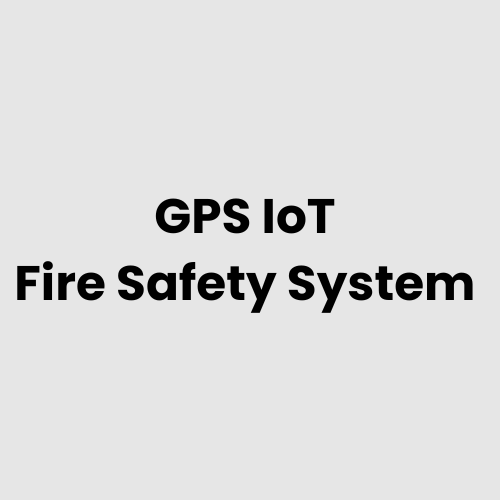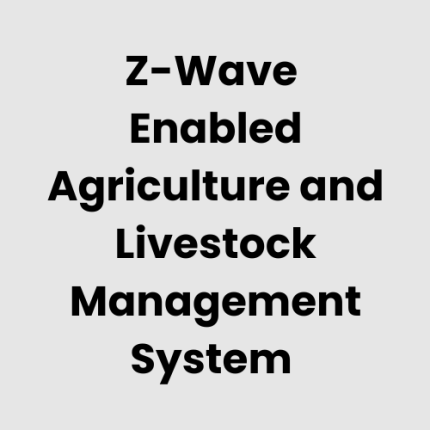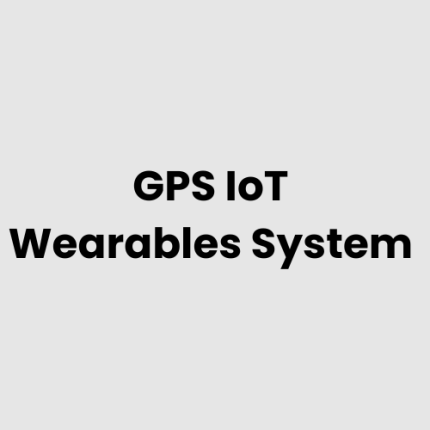Description
GPS IoT Enabled Fire Safety IoT System: Technical Architecture
The GPS IoT Enabled Fire Safety IoT System is designed to enhance fire detection, response, and prevention by using real-time data analytics, GPS tracking, and IoT sensors. The system integrates fire alarms, smoke detectors, and environmental sensors with GPS technology to pinpoint the exact location of hazards. This enables the rapid dispatch of emergency teams while continuously monitoring building conditions to prevent fire hazards. The system also features cloud connectivity for centralized data analysis and reporting, improving situational awareness and optimizing safety protocols.
List of Hardware in the GPS IoT Enabled Fire Safety IoT System
- GPS-enabled Smoke Detectors: Detect smoke and fire hazards and transmit location data in real-time to a central monitoring system.
- Temperature Sensors: Measure temperature changes to detect abnormal fluctuations that may indicate a fire or overheating.
- Environmental Sensors: Monitor air quality, humidity, and CO2 levels to identify potential fire risks or hazardous conditions.
- Fire Alarms: Trigger audible alerts upon detecting fire or smoke, integrated with GPS to notify the exact building location.
- IoT Gateway Devices: Act as communication hubs to transmit data from sensors to the cloud or local server.
- Emergency Lighting: Connected to the system to automatically activate during emergencies for safe evacuation routes.
- Battery Backup Units: Ensure system operation during power outages, providing uninterrupted data transmission and fire safety coverage.
- Control Panels: Centralized units that manage fire safety devices and interfaces, providing alerts and system diagnostics.
Physical Placement Considerations of the Hardware
- Smoke and Temperature Sensors: Install in strategic locations such as hallways, near exit points, and high-risk areas (e.g., kitchens, electrical rooms). Ensure they are at ceiling level or in areas most likely to detect smoke or heat.
- Environmental Sensors: Place in spaces where changes in air quality, humidity, or CO2 are critical, such as mechanical rooms or basements.
- Fire Alarms: Position alarms in easily accessible locations, especially near exit routes, to ensure clear auditory signals in the event of a fire. Integration with the system ensures that they are triggered automatically.
- Emergency Lighting: Install in corridors, stairwells, and near emergency exits to ensure that evacuation routes are illuminated in case of an emergency.
- IoT Gateway Devices: These should be installed centrally to optimize connectivity between sensors and central systems, ensuring reliable communication.
Hardware Architecture of the GPS IoT Enabled Fire Safety IoT System
The system architecture includes the following components:
- Sensor Layer: Consists of smoke detectors, temperature sensors, environmental sensors, and fire alarms, all integrated with GPS for precise location tracking.
- Edge Processing Layer: IoT gateway devices collect and process data from sensors, performing basic analysis and filtering before sending it to the central system.
- Communication Layer: Utilizes Wi-Fi, LTE, or LoRaWAN connectivity to transmit data from the gateway devices to either a local server or the cloud.
- Cloud Server/Local Server Layer: Centralized storage and analysis of sensor data occur here, with capabilities to manage real-time alerts, analytics, and reporting. This layer processes data from multiple locations and provides actionable insights.
- User Interface Layer: Provides a dashboard for administrators to monitor the system, receive real-time alerts, and manage fire safety protocols remotely or onsite.
Deployment Considerations of the GPS IoT Enabled Fire Safety IoT System
- Installation Site Evaluation: Conduct a thorough site survey to determine the optimal placement of sensors, alarms, and IoT gateways, ensuring reliable connectivity and coverage.
- System Configuration: Configure the system for the specific layout of the building, including the integration of environmental monitoring to handle different room sizes and conditions.
- Power Supply Setup: Ensure all devices, including IoT gateways and sensors, have stable power sources and backup systems, especially during power outages.
- Network Connectivity: For IoT connectivity, ensure reliable and secure communication infrastructure, whether cloud-based or via local servers, to prevent data loss during emergencies.
- Testing and Calibration: Perform comprehensive testing of all sensors and alarms to ensure accurate operation and response times. Fine-tune the system based on building-specific requirements.
- Ongoing Maintenance: Schedule regular system checks and software updates to ensure the system remains fully operational and responds to new threats effectively.
List of Relevant Industry Standards and Regulations
- NFPA 72: National Fire Alarm and Signalling Code
- NFPA 101: Life Safety Code
- UL 864: Standard for Control Units and Accessories for Fire Alarm Systems
- IEC 61508: Functional Safety of Electrical/Electronic/Programmable Electronic Safety-related Systems
- ISO 9001: Quality Management Systems
- ISO/IEC 27001: Information Security Management
- OSHA Fire Safety Standards
- CAN/ULC-S524: Standard for the Installation of Fire Alarm Systems (Canada)
Local Server Version: Running with a Local Server
In scenarios where cloud connectivity is unavailable or not preferred, the GPS IoT Enabled Fire Safety IoT System can be deployed using a local server. This version ensures that all data from fire safety sensors and alarms are processed and stored locally. The local server provides real-time monitoring and alerting capabilities, with no dependence on external internet connections. This is ideal for environments where data privacy and security are critical. GAO Tek can help customize the system based on specific client needs for local data processing.
Cloud Integration and Data Management
GAO Tek’s GPS IoT Enabled Fire Safety IoT System can be seamlessly integrated with cloud-based platforms, allowing for remote monitoring and real-time alerts. Cloud integration provides enhanced scalability, enabling easy expansion of the system across multiple sites. Data from sensors is securely transmitted to the cloud for analysis and reporting. Through the cloud, administrators can access detailed performance metrics, receive automated alerts, and view historical data for insights into system performance. This centralized management ensures that fire safety protocols are always up to date, regardless of location, and that data can be accessed from anywhere at any time.
GAO Case Studies of GPS IoT Enabled Fire Safety IoT System
Case Studies in the USA
- New York City, NY
A high-rise office building in Manhattan implemented the GPS IoT Enabled Fire Safety IoT System for improved emergency response. The system provided real-time data on smoke and heat levels, pinpointing the exact location of the fire, enabling a faster evacuation and quicker response from the fire department.
- San Francisco, CA
A large shopping mall in San Francisco adopted the system to integrate fire safety with IoT sensors and GPS tracking. The system not only detected fires but also provided live updates to emergency personnel on fire location and building status, improving safety for thousands of visitors.
- Chicago, IL
A university campus in Chicago used the system to enhance fire safety across its multiple buildings. The GPS-enabled sensors identified the exact floor and room where fires or smoke were detected, ensuring the quick mobilization of firefighters to the precise area.
- Los Angeles, CA
A residential complex in Los Angeles integrated the GPS IoT Enabled Fire Safety IoT System to monitor fire risks in real-time. The system allowed for immediate notifications to tenants and emergency responders, reducing the risk of extensive damage during fires.
- Houston, TX
A hospital in Houston incorporated the system to safeguard patient care areas. Real-time alerts were sent directly to hospital personnel, while the GPS system ensured that fire responders had accurate data on fire locations within the complex, allowing for a faster, more efficient response.
- Miami, FL
A large-scale hotel in Miami adopted the fire safety system to monitor fire hazards in guest rooms and common areas. The GPS tracking system provided precise room locations and alerted both guests and staff of any fire hazards in real time, significantly improving evacuation times.
- Seattle, WA
A commercial office building in Seattle deployed the GPS IoT fire safety system for real-time smoke and fire detection. The integration of environmental sensors ensured early detection of fire risks, and GPS tracking provided precise information to emergency responders during fire incidents.
- Dallas, TX
A corporate campus in Dallas used the system to improve their fire safety protocols. The GPS-enabled system helped with both smoke detection and precise location identification, reducing evacuation time and allowing for faster deployment of emergency response teams.
- Washington, D.C.
A government building in Washington, D.C. integrated the system to increase fire safety monitoring across multiple floors. The real-time GPS tracking data provided authorities with vital location information, enhancing their ability to respond quickly to fire emergencies.
- Atlanta, GA
An industrial complex in Atlanta employed the GPS IoT Enabled Fire Safety IoT System to monitor temperature and smoke levels. The system helped with early detection of fire hazards, and its GPS tracking ensured rapid identification of fire locations, enabling quick evacuation and damage control.
- Boston, MA
A research facility in Boston used the system to protect both employees and sensitive equipment. With real-time alerts and GPS-based location tracking, the system provided immediate fire hazard notifications, helping to minimize downtime and prevent damage to research projects.
- Denver, CO
A mixed-use commercial and residential building in Denver implemented the system for fire detection. It utilized the GPS tracking functionality to identify fire locations within the building, allowing for quicker evacuation and reducing damage to the property.
- Phoenix, AZ
A warehouse facility in Phoenix installed the GPS IoT Enabled Fire Safety IoT System for improved safety monitoring. The system’s environmental sensors tracked temperature and smoke, and the GPS tracking feature ensured that firefighters could be dispatched to the exact location of the hazard.
- Las Vegas, NV
A casino in Las Vegas integrated the fire safety system to ensure the safety of guests and staff in the event of a fire. The system tracked real-time data from fire and smoke detectors, and the GPS functionality allowed for precise pinpointing of fire locations within the building.
- Detroit, MI
A manufacturing plant in Detroit adopted the GPS IoT Enabled Fire Safety IoT System to monitor fire risks in hazardous areas. The system helped identify potential fire hazards early, and GPS tracking enabled emergency responders to act quickly, minimizing damage and protecting workers.
Case Studies in Canada
- Toronto, ON
A multi-story office building in Toronto implemented the GPS IoT fire safety system to enhance fire safety protocols. The system provided real-time alerts and GPS-based location tracking, improving both evacuation processes and emergency responder coordination.
- Vancouver, BC
A shopping mall in Vancouver integrated the GPS IoT Enabled Fire Safety IoT System to provide continuous monitoring of fire risks. With real-time fire detection and precise location alerts, the system increased safety for mall visitors and staff, ensuring faster responses to fire emergencies.
Navigation Menu for GPS IoT
- GPS IoT Trackers/Devices
- GPS IoT Tracking Accessories
- GPS IoT Tracking Resources
- GPS IoT – Cloud, Server, PC & Mobile Systems
Navigation Menu for IoT
- LORAWAN
- Wi-Fi HaLow
- Z-WAVE
- BLE & RFID
- NB-IOT
- CELLULAR IOT
- GPS IOT
- IOT SENSORS
- EDGE COMPUTING
- IOT SYSTEMS
Our products are in stock and can be shipped anywhere in the continental U.S. or Canada from our local warehouse. For any further information, please fill out this form or email us.
We are actively looking for partners who are like us located in the U.S. and Canada. For more information on partnering with GAO, please visit Partner with GAO Tek Inc. It lists various ways to partner with GAO, such as OEM Partnerships, Technology Integration, Distribution and Reselling Opportunities, Presenting at the Leading Event Tek Summit, Joint R&D Projects, Training and Consulting Services, Industry-Specific Collaborations, Research and Academic Partnerships.



